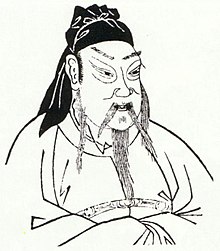

TYPE: God of war
ORIGIN: Taoist (Chinese)
KNOWN PERIOD OF WORSHIP: Circa CE 300 until present
SYNONYMS: Guan Di; Kuan Kung.
CENTER(S) OF CULT: Throughout China
ART REFERENCES: Paintings and sculptures
LITERARY SOURCES: Various philosophic and religious texts, mostly inadequately researched and untranslated.
INFORMATION: The most powerful figure in the pantheon, the god is based on an historical figure who lived CE 162-220. He was a general in the imperial army and came to prominence after a successful battle with the warlord Tung Cho. He was subsequently deified.
The epitome of austerity, loyalty and integrity, he is worshiped as the personification of the sacred principles of the hsieh or knightly warrior. He was the tutelary deity of the Chung emperors and it the god of the military, but also of restaurants, pawn shops, curio dealers and literature. He is a guardian of secret societies, including Triads, and brotherhoods, particularly in Hong Kong, but also of the police, thus many CID offices possess an altar to Kuan Ti, as Kuan Kung.
He is depicted seated on a tiger skin, sometimes with the face of a tiger on the breast of his robe. His magical sword is the "Black Dragon" and his horse is the "red hare". His festivals are celebrated on the fifteenth day of the second mooon and on the thirteenth day of the fifth moon. He thus presides over the light half of the year—spring and summer.
Images of Kuan Ti are kept by most households in China, facing the entrance of the building, to frighten way evil influences.